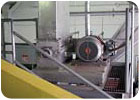
Vanilla beans from Madagascar, cinnamon bark from Sri Lanka, ginger roots from Nigeria and other natural flavors you enjoy have likely come from East Hanover, NJ-based Givaudan Flavors Corp., which extracts flavor from natural products, concentrates, packages and markets it to food and beverage manufacturers.
Givaudan processes these and other natural ingredients on a mass scale, placing high demands on its size-reduction equipment, grinding upwards of 6,000 lbs./hr. of ginger root, cassia bark or cola nuts and cutting about 3,000 lbs./hr. of vanilla beans to uniformly sized chips, within the relatively tight tolerances required for efficient flavor extraction.
During the process, organic raw materials are forklifted to the second floor of the plant and dumped into any of four dumping stations terminating at size-reduction equipment located below on a first floor mezzanine. To help with this part of the process, Givaudan relies on a rotary cutter, hammermill and roller mill to reduce material to uniform size chips, presenting the best surface area for liquid extraction of flavors.
After a bulk bag is filled with ground material, a chain hoist lifts the bag for emptying into one of several box extractors or 20-ft. high conical extractors. Liquid flavor is derived from vanilla beans, for example, at a 1:10 ratio, says Joe Bush, basic products maintenance supervisor.
Throughput of 6,000 lbs./hr. of tough, hard roots, beans and nuts places high demand on the blades of the rotary knife cutter, which must be very rugged to handle the impact, yet give a precise cut with minimum fines and dust. Givuadan needed to replace its older rotary cutter with one that could handle these tough tasks and keep downtime to a minimum.
According to Bush, the Munson SCC 30 rotary knife Givuadan selected does just that thanks to efficient blade replacement, which Givaudan performs every six months. He says blade changing takes four hours now compared to one-and-a-half days with the previous knife cutter. The five rotor knives and four stationary knives fit into slots for easy bolting and unbolting. Additional time saving derives from a Munson tool for adjusting the clearance between the rotor and stationary knives. The rotary knife cutter this machine replaced required lengthy measurement and adjustment of knife clearance with a feeler gauge.
The former knife cutter attained a throughput rate of 1,990 lbs./hr. with a 60 hp motor, where the Munson unit, driven by a 20 hp variable speed drive at 550 rpm, triples that rate. Also, a wider 270-degree screen permits higher throughput compared to the replaced cutter's 120-degree screen area.
With a second Munson machine, a stainless steel screen classifying cutter, Givaudan chops vanilla beans at a rate of 3,000 lbs./hr. The rotary cutter attains high throughput with a helical rotor assembly of dozens of interconnected parallelogram-shaped cutters, each holding two tungsten carbide cutter inserts. Cutting action occurs as the carbide tips pass within thousandths of an inch of two stationary bed knives. The rotor configuration produces a spiral cutting and feeding effect.
The carbide inserts are replaceable, but Bush replaces the entire rotor assembly every three years, since the tungsten carbide teeth last long even in this abrasive application. "Cleaning of the rotary and knife cutters between batches proceeds rapidly," says Bush. The operator flushes out the cutting chambers with nitrogen and rinses with water.
For more information:
Munson Machinery Co.;
800-944-6644;
info@munsonmachinery.com
